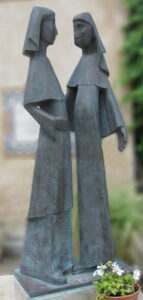Is a Marist Mission Vocation Critical to the Church Today?

By Fr John Larsen SM
A missionary perspective by Fr. John Larsen, SM, Superior General of the Society of Mary, Rome, Italy. First published in Vocations News, a newsletter of the US Province of the Society of Mary.
After ordination in 1981, John taught for five years at St Patrick’s College, Silverstream.
After experience of mission in the Philippines, Myanmar (Burma), and Ranong, Thailand, Fr John was involved in the formation of Marist priests. He was also novice master in the Philippines and Rector of the Marist International Theologate in Rome.
Isn’t it ‘passé’ to think of being a missionary these days? We sometimes used to think of missionaries as exotic men or women who left home and country to bring the Good News of Jesus Christ to very foreign lands: Mission Sisters and Columbans in Asia, Marists in the Pacific, South America and Asia. Many men and women all over the globe. Often there was something heroic in our picture of them. At least that is how it used to be for me, long ago. Later on, we came to hear that some missionaries brought not only the Gospel but also rather too much of their home cultures and personalities which could sometimes almost overwhelm the Gospel message.
Then the whole understanding of mission changed. Now we were all called to be missionaries. We remembered that God himself is essentially and actively a loving-mission and that we all share in his mission by our Baptism. However, if everyone is a missionary is anyone specifically a missionary?
The Christian world that had traditionally sent the missionaries is now only questionably Christian. Perhaps ‘the mission’ to bring the Gospel was now primarily at home? Some of the places where missionaries were traditionally sent now rejoice in more vibrant local churches than the sending communities. In fact, a phenomenon of ‘reverse mission’ has developed so that these receiving countries are often now the new sending churches. Also, in the economically developed world there are less people putting up their hands to volunteer for full-time mission abroad.

Fr Emmet McHardy SM. Missionary to North Solomons, now Bougainville mission c 1929
Amidst a possible ambivalence towards mission and missionaries, Mary offers us a sure way into the future. Mary speaks to us from Nazareth saying that the first mission is indeed at home, recognising Christ in the insignificance of our ordinary lives and work. Being a missionary like Mary is not necessarily first and foremost about travelling to a remote foreign land, but forming a missionary heart right where we are, our own ‘Nazareths’, working alongside the presence of Christ among us, to nourish our local families and communities.
Mission, as much as charity, may indeed begin at home. However, Mary heading off into the hill country of Judah to visit her cousin Elizabeth in her challenging situation, is a call to be flexible enough to leave the comfort of home going “in haste” to wherever there is a need. Or the comfort of our own limited plans and dreams. Mary takes with her the Word in her womb and Elizabeth’s baby jumps for joy. The missionary call is rooted in contemplative prayer as we celebrate every time we pray the Magnificat with Mary and Elizabeth, the prayer which they first prayed together joyfully in that remote Judean hill country. Mary at Golgotha reminds us that mission includes staying alongside those who are suffering at the margins of society. Marist missionaries will be the presence of Mary alongside those who are oppressed and rejected, seeing in them the tortured body of her Son.

Statue of the Visitation at the Church of the Visitation in Ein Karem, Israel
The days of the isolated missionaries, lone-ranger boundary riders, are gone. We see Mary at her missionary best among the community of the early disciples, sent forth on mission with the fire of the Holy Spirit at Pentecost. Marist missionary life involves dynamic, welcoming, out-going communities, united in the Holy Spirit.
One of the famous spiritual guidelines of our Marist Founder, Fr. Jean-Claude Colin, is that Marists are called to be “hidden and unknown in the world”. This is not only a call to a discreet personal spirituality. It is also, and much more, a missionary call. Who are the “hidden and unknown” of this world? They are people who are nameless because they are forgotten. They are unknown because no-one cares. A Marist missionary, like Mary, stands in solidarity with the “hidden and unknown of this world” and accompanies them to develop their ability to make their own voices sing confidently, voices of justice and peace and joy in the Kingdom of God.
Old-world ways of understanding missionaries and ‘mission’ have changed. Mary in the New Testament shows us the way forward. She is never a mere plaster statue. She is a dynamic missionary woman whose spirit we Marist missionaries live and breathe. We are all called to be missionaries in the Spirit of Mary wherever we find ourselves. This mission is perennial.
 Entries(RSS)
Entries(RSS)